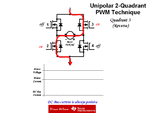righteous
Full Member level 2
Gents,
I'm working on my BLDC and learn at the same time, but I'm getting more and more confused due to the liberal interchange of terms i.e. EMF, BEMF, CEMF and Flyback. I'm trying to keep the TI blog So, Which PWM Technique is Best? as authoritative as the terms are explained before they are utilized, except when they are not... as the case is here.
Definition of Terms:
EMF = Is the energy produced in the coil by the passing magnets (But some people also use the term BEMF/CEMF deliberately just to confuse me ;-)
BEMF= Back-EMF Is the energy expelled by the coil when its magnetic field collapses, alternatively the term "flyback" can be used.
In Part II of the blog it states
So my question is; is this a depiction of EMF or BEMF when Q2 is OFF? As the text says "flyback" and the drawing states "Motor Back EMF", so do they mean "Motor Back EMF" as in BEMF=Flyback? Or is it another case of term confusion where "Motor Back EMF" as in EMF definition?
ANIMATED GIF PICTURE (You may need to tell your browser to play gif's)

And if it is BEMF, what happens to that trapped energy? Is it being put to use in driving the motor, or does it simply just loop around until it "evaporates" as there is no ground potential (current loop)?
I'm working on my BLDC and learn at the same time, but I'm getting more and more confused due to the liberal interchange of terms i.e. EMF, BEMF, CEMF and Flyback. I'm trying to keep the TI blog So, Which PWM Technique is Best? as authoritative as the terms are explained before they are utilized, except when they are not... as the case is here.
Definition of Terms:
EMF = Is the energy produced in the coil by the passing magnets (But some people also use the term BEMF/CEMF deliberately just to confuse me ;-)
BEMF= Back-EMF Is the energy expelled by the coil when its magnetic field collapses, alternatively the term "flyback" can be used.
In Part II of the blog it states
Texas Instruments said:[....]the inductive flyback current is “trapped” in the top half of the H-Bridge, and never flows back into the DC bus
So my question is; is this a depiction of EMF or BEMF when Q2 is OFF? As the text says "flyback" and the drawing states "Motor Back EMF", so do they mean "Motor Back EMF" as in BEMF=Flyback? Or is it another case of term confusion where "Motor Back EMF" as in EMF definition?
ANIMATED GIF PICTURE (You may need to tell your browser to play gif's)

And if it is BEMF, what happens to that trapped energy? Is it being put to use in driving the motor, or does it simply just loop around until it "evaporates" as there is no ground potential (current loop)?